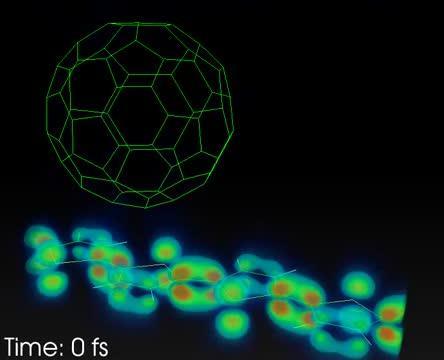Will the new results immediately lead to better solar cells? "Such ultrafast spectroscopic studies, and in particular their comparison with advanced theoretical modelling, provide impressive and most direct insight in the fundamental phenomena that initiate the organic photovoltaic process. They turn out to be very similar to the strategies developed by Nature in photosynthesis.", says Lienau. "Recent studies indicate that quantum coherence apparently plays an important role in that case. Our new result provide evidence for similar phenomena in functional artificial photovoltaic devices: a conceptual advancement which could be used to guide the design of future artificial light-harvesting systems in an attempt to match the yet unrivalled efficiency of natural ones . "

Real time quantum simulation of the conversion of light into current in an organic solar cell composed of a polymer chain, and a Fullerene buckyball. The movie lasts for about 100 femtoseconds (fs), and is slowed down by about three hundred thousand billions of times with respect to the real phenomenon, in order to make the ultrafast time scale visible to humans. The quantity depicted illustrates the wavelike oscillations of an electron after light is absorbed at time 0. Each time the upper "bulb" (actually a Fullerene molecule) lights up, a current flows from the bottom to the top of the miniature solar cell. The inset quantifies the amount of charge transfered from the polymer to the Fullerene as a function of time.
(Photo Credit: Carlo A. Rozzi, Istituto Nanoscienze Cnr)

This film strip contains frames taken from the quantum simulation of a portion of an organic solar cell. The quantity depicted illustrates the wavelike oscillations of an electron after sun light is absorbed at time 0. The time scale is in femtoseconds (fs). [One fs is one millionth of billionth of a second.] The two parts of the system separated by a small space act as the poles of a microscopic sun-operated battery. Each frame depicts a scene about 2 nanometers wide. [One nanometer is a millionth of a millimeter.]
(Photo Credit: Carlo A. Rozzi, Istituto Nanoscienze Cnr)
Source: Istituto Nanoscienze -- CNR